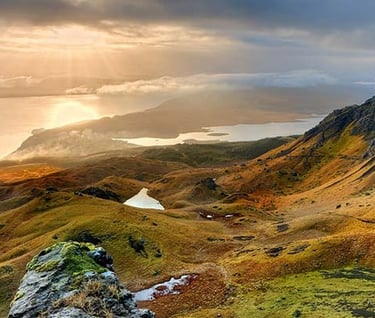
Subscribe to our newsletter
Delving Deep into the Craftsmanship of Highland Whiskies
11/28/20232 min read


The Highland Whisky Craft: An Alchemy of Nature and Tradition
The Scottish Highlands, a land of mystic lochs and towering mountains, is also the birthplace of some of the world's most exquisite whiskies. In this week's Spirits Series, we're taking a closer look at the intricate craftsmanship behind Highland whiskies, revealing how terroir, distillation, and maturation intertwine to create liquid masterpieces.
Terroir: The Highland Landscape
The concept of terroir is as crucial in whisky as it is in wine. The unique combination of climate, geography, and local ingredients in the Highlands imparts distinctive characteristics to the whisky. The region's pure water, sourced from natural springs and streams, is rich in minerals and plays a pivotal role in the fermentation process, influencing the final flavour profile. The cool, damp climate of the Highlands also contributes significantly, allowing for a slow and steady maturation process.
The Art of Distillation
Highland whisky distillation is an art form, passed down through generations. The process begins with malted barley, which is ground into a coarse flour known as grist. This grist is mixed with warm water in a mash tun, converting starches into sugars. The liquid, now called wort, is then fermented by adding yeast. This fermentation process is where the magic begins, turning the sugary wort into a crude beer.
The spirit is then distilled, often twice, in traditional copper pot stills. These stills are fundamental to the whisky's character, with their shape and size influencing the final spirit's richness and complexity. The first distillation produces a liquid called 'low wines', and the second distillation further refines this into 'new make spirit', the heart of the whisky.
Aging: The Patience of Perfection
After distillation, the spirit begins its aging journey. Highland whiskies are typically aged in oak barrels, which previously held sherry, bourbon, or other spirits. This maturation is where the whisky develops its depth, character, and colour. Interaction with the oak wood infuses the whisky with a range of flavours - from vanilla and caramel to rich fruit and spice notes. The length of this aging process varies, with some whiskies maturing for decades, each year adding layers of complexity.
Five Highland Whiskies: A Testament to Craftsmanship
Glenmorangie Signet: Aged in bespoke oak casks, this whisky is a rich fusion of chocolate, coffee, and citrus - a sophisticated expression of Highland craftsmanship.
Dalmore 18 Year Old: Sherry and bourbon cask aging lend this whisky a complex profile of chocolate, tropical fruits, and spices - a reflection of elegance and luxury.
Oban 14 Year Old: A classic coastal whisky, offering a unique combination of sea salt, citrus, and smoke - a true testament to the West Highlands' maritime terroir.
Clynelish 14 Year Old: From the wild landscapes of the Highlands, this whisky is a harmonious blend of honey, dried fruit, and waxed citrus, encapsulating the essence of its rugged origins.
Edradour 10 Year Old: Produced in Scotland's smallest distillery, this gem exemplifies the impact of small-scale, artisanal whisky-making, with its creamy, nutty profile and hints of fruitcake and smoke.
In Summary: Highland Whisky, A Symphony of Elements
Highland whiskies are not just spirits; they are symphonies of the natural elements and human ingenuity. From the terroir that shapes their character to the aging process that refines their flavours, these whiskies are a testament to the craft and tradition of the Scottish Highlands. Each sip is a journey through time and landscape, offering a glimpse into the soul of one of the world's most beloved spirits.
To explore the richness of Highland whiskies and their unique craftsmanship, visit marialauraortiz.com. Subscribe to our newsletter for more insights into the world of fine spirits and luxury living.
